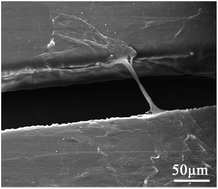hMSCs bridging across micro-patterned grooves
Abstract
The effect of topography on hMSCs has been widely investigated in recent years. In this study, hMSCs exhibited complex behavior in addition to “contact guidance” on micro-grooved substrates that contained grooves of dimensions ranging from tens to hundreds of microns. A unique growth pattern demonstrated was that hMSCs spanned across grooves with 100 μm widths between adjacent plateaus. hMSCs on the bottom of a groove had their possible adhesion positions explored and it was discovered that they spanned across grooves by climbing the side walls of grooves. Besides, hMSCs only bridged across a groove when the ratio of groove width to depth was less than two. Furthermore, disorganized parallel actin stress fibers and enhanced actin edge-bundles were obviously revealed by characterization of F-action. However, according to results from AFM and immunofluorescence experiments, there was no difference between the bridging hMSCs and normal spreading hMSCs on stiffness, and expression of desmin and osteocalcin, respectively. The results from this study offer more information to understand the interaction between hMSCs and micron topography, and they influence the design of future tissue engineering scaffolds that tailor topographical features so as to optimize cell–scaffold interactions.


 Please wait while we load your content...
Please wait while we load your content...